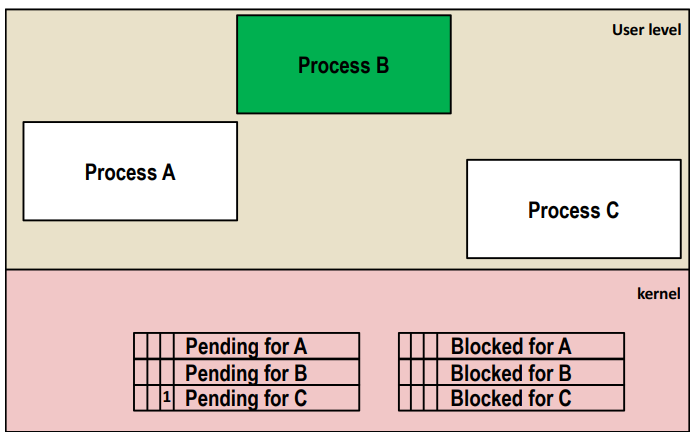深入理解计算机系统_3e 第八章家庭作业 CS:APP3e chapter 8 homework
8.9
关于并行的定义我之前写过一篇文章,参考:
并发与并行的区别 The differences between Concurrency and Parallel
+----------------------------+
| Process pair Concurrent?|
+----------------------------+
| AB N |
| |
| AC Y |
| |
| AD Y |
| |
| BC Y |
| |
| BD Y |
| |
| CD Y |
+----------------------------+
8.10
A.
fork
B.
execve longjmp
C.
setjmp
8.11
4次
+--------------> printf("hello\n")
|
| Fork
| i = 1
+------------+--------------> printf("hello\n")
|
|
| +--------------> printf("hello\n")
| |
| |
| |
+--------+------------+--------------> printf("hello\n")
Fork Fork
i = 0 i = 1
8.12
8次
main
+-------> printf("hello\n")+--------> printf("hello\n")
| main
+-----+-------> printf("hello\n")+--------> printf("hello\n")
| Fork
Fork| Fork main
+-------------+-------> printf("hello\n")+--------> printf("hello\n")
| | main
+----+ +-------> printf("hello\n")+--------> printf("hello\n")
doit()
8.13
保证x=4在x=3之前即可(拓扑排序),有三种情况:
A.
x=2 x=4 x=3
B.
x=4 x=2 x=3
C.
x=4 x=3 x=2
"x=4" "x=3"
+-------> printf("%d\n", ++x) +---> printf("%d\n", --x) +-->
|
|
|
+---------+-------> printf("%d\n", --x) +---------------------------->
x = 3 Fork
"x=2"
8.14
3次
+-------> printf("hello\n") +--->
|
+-----+-------> printf("hello\n") +--->
| Fork
Fork| main
+-------------------------------------------------> printf("hello\n")
|
+----+
doit()
8.15
5次
main
+-------> printf("hello\n")+--------> printf("hello\n")
| main
+-----+-------> printf("hello\n")+--------> printf("hello\n")
| Fork
Fork| main
+-------------------------------------------------> printf("hello\n")
|
+----+
doit()
8.16
counter = 2
更新(李治霖指出错误):虽然子进程对counter进行了减一操作,但是子进程和父进程并没有共享内存,即不会影响父进程的变量
+--> counter-- +--+
| |
counter=1 | v
+--+-------------->Wait(NULL)+--> printf("counter = %d\n", ++counter);
Fork
8.17
假设子进程正常退出;构成拓扑排序即可,有三种情况:
A.
Hello 1 Bye 0 2 Bye
B.
Hello 1 0 Bye 2 Bye
C.
Hello 0 1 Bye 2 bye

8.18
构成拓扑排序即可,ACE正确。
B中的第一个不可能是2。D中的第一个1后面不可能有两个2。
+-->printf("0")+--->printf("2")
|
+----->atexit+-+-->printf("1")+--->printf("2")
| Fork
| Fork
+---+--------------+-->printf("1")
Fork |
+-->printf("0")
8.19
2^n
每次Fork都会使原来的进程数翻倍,最后每一个进程都会输出一行,所以是2^n行。
8.20
书上说改变COLUMNS环境变量会使得ls改变输出的宽度,但是在我的机器上即使用export改变该环境变量后,如果我再调用ls ,其依然按照终端的宽度输出,而且COLUMNS被改变回原来的值,我怀疑是调用ls的时候系统重新探测终端宽度并设置了新的COLUMNS。
#include <unistd.h>
#include <errno.h>
#include <stdio.h>
int main(int argc, const char *argv[], const char *envp[])
{
if (execve("/bin/ls", argv, envp))
{
perror("Failed to execve /bin/ls:\n");
}
return 0;
}
类型不一致可能会报警,这里不会有问题。

8.21
满足拓扑排序即可,两种情况:
A.
abc
B.
bac
+----->printf("a")+-------+
| |
| v
+---+----->printf("b")+--->waitpid+--->printf("c")+-->
fork
8.22
根据man 3 system 的部分描述:
The system() library function uses fork(2) to create a child process that executes the shell command specified in command using execl(3) as follows:
execl("/bin/sh", "sh", "-c", command, (char *) 0);
我们可以得到execl调用后的进程关系图:

根据man sh的部分描述:
EXIT STATUS
Errors that are detected by the shell, such as a syntax error, will cause
the shell to exit with a non-zero exit status. If the shell is not an
interactive shell, the execution of the shell file will be aborted. Oth‐
erwise the shell will return the exit status of the last command exe‐
cuted, or if the exit builtin is used with a numeric argument, it will
return the argument.
可以看到Otherwise the shell will return the exitstatus of the last command executed这句话,也就是说,command执行的状态会称为sh的返回状态,所以我们回收sh并判断其返回状态即可。
#include <sys/wait.h>
#include <sys/types.h>
#include <unistd.h>
#include <stdio.h>
int mysystem(char *command)
{
pid_t sh_pid;
int sh_status;
if ((sh_pid = fork()) == 0)
{
execl("/bin/sh", "sh", "-c", command, (char *) 0);
}
else
{
if ((waitpid(sh_pid, &sh_status, 0)) == sh_pid)
{
if (WIFEXITED(sh_status))
{
return WEXITSTATUS(sh_status);
}
else if (WIFSIGNALED(sh_status))
{
fprintf(stderr, "command terminated by signal number %d.\n", WTERMSIG(sh_status));
if (WCOREDUMP(sh_status))
{
fprintf(stderr, "core dumped...\n", );
}
return WTERMSIG(sh_status);
}
else
{
fprintf(stderr, "command terminated abnormally.\n");
fprintf(stderr, "return status information...\n");
return sh_status;
}
}
else
{
fprintf(stderr, "Failed to reap /bin/sh.\n");
return EXIT_FAILURE;
}
}
}
8.23
一个典型的信号不能累加的问题。
当子进程连续向父进程发送5个SIGUSR2信号时,第一个信号传送过程如下,其中A代表子进程,C代表父进程:




当父进程C接到信号后,它进入信号处理函数,并暂时将这个信号屏蔽(设置block位),这时子进程还在不断的向父进程发送所有剩下的同类信号,pending位被再次置1,而接下来的信号则会被遗弃(只有一个pending位,没办法计数),当父进程C的信号处理函数退出后,block位被置零,刚刚pending的信号再次被送入父进程C,父进程再次进入信号处理函数,这时子进程已经完成所有的信号发送,所以父进程不会再次进入信号处理函数了。综上,父进程C只会进入两次信号处理函数,即counter只会被加2而非5。
8.24
书上说要使用库函数psignal信号的描述,man 3 psignal描述如下:
#include <signal.h>
void psignal(int sig, const char *s);
The psignal() function displays a message on stderr consisting of the string s, a colon, a space, a string describing the signal number sig, and a trailing newline. If the string s is NULL or empty, the colon and space are omitted. If sig is invalid, the message displayed will indicate an unknown signal.
将Figure 8.18的代码改为:
#include <stdio.h>
#include <signal.h>
#include <sys/wait.h>
#include <sys/types.h>
#include <errno.h>
#include <unistd.h>
#define N 2
int main()
{
int status;
pid_t pid;
for (int i = 0; i < N; i++)
{
if (((pid = fork()) == 0))
{
int *p = 0;
*p = 0; /* Segmentation fault (core dumped) */
return 0;
}
}
while ((pid = wait(&status)) > 0)
{
if (WIFEXITED(status))
{
printf("child %d terminated normally with exit status=%d\n"
, pid, WEXITSTATUS(status));
}
else if (WIFSIGNALED(status))
{
fprintf(stderr, "child %d terminated by signal %d"
, pid, WTERMSIG(status));
psignal(WTERMSIG(status), " ");
}
else
{
fprintf(stderr, "child %d terminated abnormally with status information=%d\n"
, pid, status);
}
}
if (errno != ECHILD)
{
fprintf(stderr, "waitpid error");
}
return 0;
}
运行输出:

8.25
倒计时可以用alarm实现,其到指定时间后会raise一个SIGALRM信号, man 2 alarm部分描述:
#include <unistd.h>
unsigned int alarm(unsigned int seconds);
alarm() arranges for a SIGALRM signal to be delivered to the calling process in seconds seconds.
If seconds is zero, any pending alarm is canceled.
In any event any previously set alarm() is canceled.
我们收到这个信号后,就要想办法终止等待中的读入并返回NULL。其中一个办法是使用setjmp.h ,我们在第一次使用setjmp(buf)时进入正常的读入(此时setjmp返回值为0),但当信号出现(时间截止),信号处理函数就会longjmp(buf,1) (此时setjmp返回值为1),根据返回值的不同,这时我们便进入return NULL语句。
#include <stdio.h>
#include <signal.h>
#include <unistd.h>
#include <setjmp.h>
#define TIMEOUT ((unsigned int)5)
#define SIZEOFBUF 1024
jmp_buf buf;
void SIGALRM_handler(int signum)
{
longjmp(buf, 1);
}
char *tfgets(char *s, int size, FILE *stream)
{
if (signal(SIGALRM, SIGALRM_handler) == SIG_ERR)
{
perror("Failed to install SIGALRM_handler");
return NULL;
}
else
{
alarm(TIMEOUT); /* raise SIGALRM after TIMEOUT seconds */
}
if (!setjmp(buf))
{
return fgets(s, size, stream);
}
else /* longjmp from SIGALRM_handler */
{
return NULL;
}
}
int main(int argc, char const *argv[])
{
char temp_bufer[SIZEOFBUF];
char *result = tfgets(temp_bufer, SIZEOFBUF, stdin);
if (result)
{
printf("Input : %s\n", result);
}
else
{
fprintf(stderr, "Time out!\n");
}
return 0;
}
运行输出(第二次输入超时):

8.26
这个四星的题目实际上就是本章对应的ShellLab(tsh)实验,我做了以后会把该实验对应的writeup链接发上来。
**更新:CS:APP3e 深入理解计算机系统_3e ShellLab(tsh)实验 **




